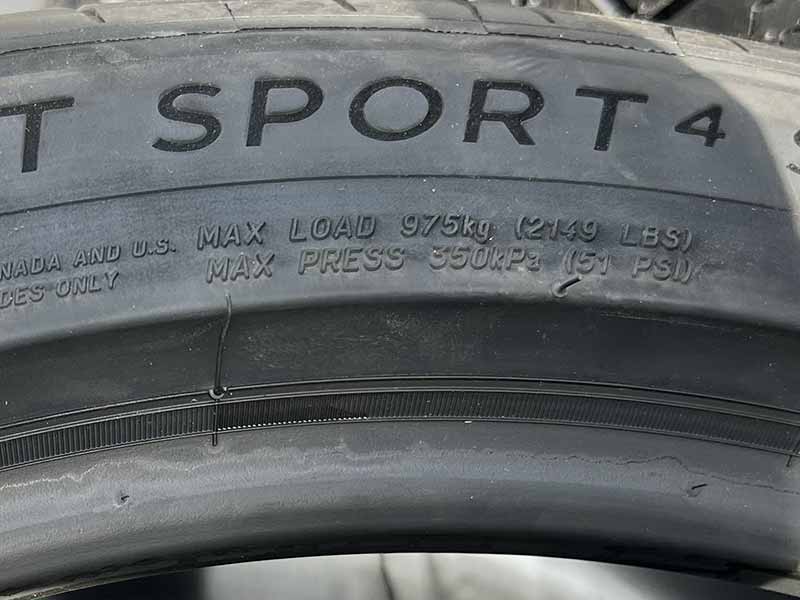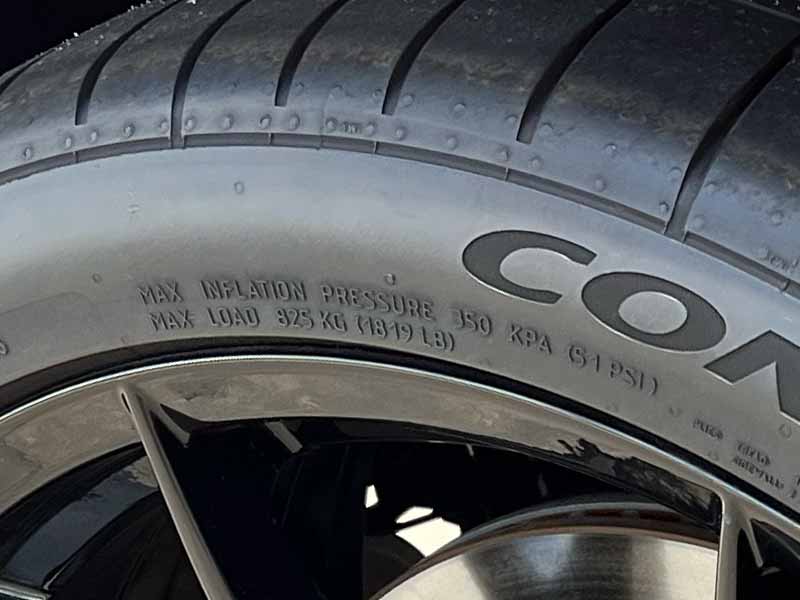Have you ever stared at the side of your tire, puzzled by all the cryptic numbers and letters, and wondered, “What does all of this mean?” Don’t worry, you’re not alone! The world of tire pressure can be a bit confusing, but it doesn’t have to be.
What Is The Max PSI For Tires?
The maximum PSI (pounds per square inch) for tires is the highest air pressure your tires can safely hold. However, this is not the recommended tire pressure, which is usually much lower and can be found in your vehicle’s driver’s door jamb or owner’s manual.
In this article, we will unravel the mysteries of tire pressure, exploring everything from what maximum PSI really means to how close to that maximum your tire pressure should be. We’ll discuss the dangers of overinflation and underinflation, provide a guide on how to remove excess air from your tires, and equip you with the knowledge to maintain optimal tire pressure for your vehicle.
Let’s take a closer look.

What Is Max PSI?
‘PSI’ stands for ‘Pounds per Square Inch.’ This is a measure of air pressure. When we talk about the ‘Max PSI’ of a tire, we’re referring to the maximum air pressure that the tire can safely handle. This is a number set by the tire manufacturer, and it’s really important to be aware of it.
You can find the Max PSI of your tire on its sidewall. It’s typically part of the tire information molded into the rubber. It’ll be something like ‘Max Load 1000 lbs at 51 PSI.’ That ’51 PSI’ is the Max PSI.
Why Should I Care About Max PSI?
Now, you might be wondering, ‘Why does this Max PSI matter to me?’ Great question! Here’s why:
- Safety: If you inflate a tire beyond its Max PSI, it can lead to a tire blowout while driving. That’s as dangerous as it sounds, and we want to avoid it.
- Tire Life: Overinflating a tire to its Max PSI can make the tire wear unevenly, reducing its lifespan. So, paying attention to the Max PSI can save you money in the long run.
Max PSI and High Air Pressure: What’s the Connection?
High air pressure in tires is directly related to the Max PSI. If you inflate a tire to its maximum inflation pressure (that’s another term for Max PSI), you are creating a condition of high air pressure.
High air pressure can make the tires too hard. This can affect your vehicle’s performance by reducing the tire’s grip on the road and making the ride less comfortable.
Here’s the main takeaway: the Max PSI is an important number, but it’s not a target. In fact, it’s a limit you should try not to reach. Up next, we’ll explain the difference between the Max PSI and the recommended tire pressure. They’re not the same thing, and understanding the difference can help keep your tires in tip-top shape.

What Is Recommended Tire Pressure?
In simple terms, the recommended tire pressure is the ideal amount of air your tires need to perform optimally. Unlike the Max PSI, which is found on your tire’s sidewall, you can find the recommended tire pressure in two key places:
- Your vehicle’s owner’s manual
- The vehicle placard, usually located on the driver’s side door jamb, inside the glove box door, or within the gas tank hatch
The recommended tire pressure is measured in PSI (Pounds per Square Inch), just like Max PSI. However, it’s typically a lower number. Why? Because the recommended pressure takes into account both safety and performance, giving you the best balance of the two.
How Is Recommended Pressure Different from Max PSI?
The key difference between the recommended tire pressure and Max PSI is this:
- Max PSI is the highest air pressure your tires can handle before they risk being damaged or cause safety issues.
- Recommended tire pressure is the ideal air pressure for the best balance of performance, safety, and fuel economy.
Just to give you an idea, let’s say your tire has a Max PSI of 51. Your vehicle’s manufacturer might suggest a recommended tire pressure of 32 PSI. That’s quite a bit lower than the maximum, isn’t it?
Why Is the Recommended Pressure Lower Than the Max PSI?
There’s a good reason why the recommended tire pressure is lower than the Max PSI. Tires filled to the max could lead to a rough ride and excessive wear in the center part of the tire. Plus, it leaves no room for additional air that might be added due to heat from driving or changes in the outside temperature.
By setting the recommended pressure lower, it allows the tire to flex and absorb road shock better. It also offers a more comfortable ride, while keeping your tires in good shape for longer. Now, who doesn’t want that?
Is It Better to Overinflate or Underinflate Tires?
Now, let’s address a debate that’s been around for quite some time: If you had to choose, is it better to overinflate or underinflate your tires? To cut to the chase, both are not ideal. However, understanding the risks of both will help you see why maintaining the recommended tire pressure is crucial.
The Dangers of Overinflation
As we’ve discussed before, overinflation leads to a few significant issues:
- Safety Risks: Overinflated tires are more susceptible to damage from potholes or debris on the road. They also have a higher risk of a blowout, which could lead to loss of vehicle control.
- Uneven Wear: The center of the tire bulges and wears out faster when a tire is overinflated, which reduces the tire’s lifespan.
- Reduced Comfort: The ride is bumpier and less comfortable due to the tires’ reduced ability to absorb road shocks.
The Risks of Underinflation
Now let’s take a look at the problems that come with underinflation:
- Increased Tire Wear: Underinflated tires can wear out more on the edges of the tread, leading to faster tire wear.
- Reduced Fuel Economy: Lower tire pressure increases rolling resistance, which can lead to decreased fuel economy.
- Handling Issues: Underinflated tires may negatively impact your vehicle’s handling, making it harder to steer, especially at higher speeds.
Striking the Right Balance
In the end, the debate between overinflation and underinflation can be a bit misleading. It’s not about choosing the lesser of two evils. Instead, it’s about understanding the importance of proper inflation. Keeping your tires inflated to your vehicle manufacturer’s recommended PSI is the best way to ensure optimal safety, performance, and tire life.

JACO Tire Pressure Gauge With Release Valve
How to Remove Too Much Air in Tire
So, you’ve accidentally overinflated your tires. No need to panic, it happens to the best of us! Thankfully, removing excess air from your tires is a straightforward process. Here’s how you do it.
Get a Tire Pressure Gauge
First things first: You’re going to need a tire pressure gauge. This handy tool allows you to check the current air pressure in your tires. Remember, knowledge is power!
Check Current Tire Pressure
Now that you have your gauge, use it to check the current pressure in your tires. The process is simple:
- Remove the valve cap from your tire (that’s the little cap on the round, metal stem protruding from your tire).
- Press the tire pressure gauge onto the valve stem. Make sure you’re doing it evenly to get an accurate reading.
- Read the gauge to see what your current tire pressure is.
Let Out Some Air
Now that you know your current pressure, it’s time to let out some air. To do this:
- Press the small, metal stem in the center of the valve. This will release air from the tire. You might want to use a small tool or the tip of the tire pressure gauge if it has a built-in feature for this.
- Don’t press too hard or too long. Air will release quickly! It’s better to let out a little air at a time.
- Repeat the process of checking the pressure with your gauge and releasing air until your tires are at the recommended PSI.
Check Tire Pressure Again
Once you think you’ve let out enough air, use your tire pressure gauge to check the pressure again. Repeat the process until you’ve reached the recommended tire pressure for your vehicle.
Resources
Below are some links you may find helpful when learning about tires
- What is the maximum load inflation pressure for a tire? – Tire Rack
- Recommended tire pressure for your tires – Pirelli
Final Thoughts
Understanding tire pressure is crucial not just for vehicle maintenance but also for your safety on the road. The key takeaway is that the maximum PSI inscribed on your tire is not a target, but rather the maximum limit your tires can safely handle. The recommended tire pressure is usually lower, and you can find it in your vehicle’s owner’s manual.
Remember, neither overinflation nor underinflation is desirable; both can lead to uneven tire wear, reduce fuel economy, and compromise the vehicle’s handling. Always aim for the manufacturer’s recommended tire pressure for optimal safety, comfort, and performance. And if you’ve overinflated your tires, don’t fret – letting out some air is straightforward, with the aid of a tire pressure gauge. Keep these key points in mind, and you’ll be well on your way to extending your tire’s lifespan and ensuring a smoother ride.
Good luck and happy motoring.




